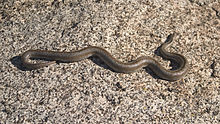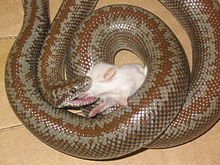- Rosy boa
-
Rosy Boa 
Conservation status Scientific classification Kingdom: Animalia Phylum: Chordata Class: Reptilia Order: Squamata Suborder: Serpentes Family: Boidae Subfamily: Erycinae Genus: Lichanura Species: L. trivirgata Binomial name Lichanura trivirgata
Cope, 1861The Rosy Boa (Lichanura trivirgata) is a snake of the Boidae family, one of only two members of that family native to the United States. The other is the Rubber Boa (C. bottae). Rosy Boas are native to the American Southwest, and Baja and Sonora Mexico.
Contents
Description
These small attractive snakes attain a length of 39 in (1 m) (though some specimens from the coast of California reach 4 feet) and a large adult has a body width about the diameter of a golf ball. Coloration in Rosy Boas is highly variable. The common name is derived from the rosy or salmon coloration that is common on the belly of Rosy Boas originating from coastal southern California and Baja Mexico. Most Boas do not have this ventral coloration but instead have a series of dark to orange spots on a light-colored background.
Almost all Rosy Boas have at least some trace of three longitudinal stripes, one down the center of the back, and two on the lower sides. The appearance of these stripes varies widely from extremely straight and having high contrast with the interspaces to extremely broken with almost no contrast with the interspaces. Stripe colors can be orange, maroon, rust, brown, or black. The interspaces range from shades of light to dark gray, yellow, or tan.
Geographic range
The Rosy Boa is found in the southwestern United States in the states of California and Arizona, and northwestern Mexico in the states of Baja California and Sonora. In California, the Rosy Boa ranges throughout the Colorado and Mojave deserts and also occupies the coastal areas of Los Angeles, Orange, Riverside, and San Diego counties. In Arizona, the Rosy Boa occupies the Mojave desert and the western areas of the Sonoran desert. It is absent from the eastern and northern halves of the state. In Sonora, the Rosy Boa ranges from the border with the United States south throughout the Sonoran Desert to at least as far south as Ortiz. In Baja California, the Rosy Boa is almost ubiquitous ranging throughout the entire peninsula except in areas of extremely dry or rockless desert.
Behavior
Rosy Boas spend most of their lives concealed beneath rocks and in crevices to escape the elements and natural predators. Granite outcroppings are the most common geologic association inhabited by the Rosy Boa. Less often they are found in association with volcanic or other rock types. Only in rare places do Rosy Boas inhabit rockless environments. In areas with few rocks Rosy Boas will use rodent burrows for concealment.
Rosy Boas' activity season follows local weather patterns; however, they are generally dormant during the winter, and active during the spring, summer and fall. Like all snakes, they are dependent on external temperatures to promote such normal bodily functions as digestion and gestation. Throughout most of their range the winter is too cold for these functions and the Rosy Boas go into a dormant state called brumation. The spring is breeding season for Rosy Boas, resulting in their highest rate of activity. Most Rosy Boas are encountered in spring as they leave the security of their rock piles and crevices to seek mates. Another reason Rosy Boas may be active on the surface of the ground is to find prey or new territory.
The surface activity of Rosy Boas can take place during any hour of the day, but during hot weather they are primarily nocturnal. In the spring, they are often abroad in the afternoon and early evening. In the late spring and summer, this activity period switches to from dusk to late into the night. Because most populations of Rosy Boas live in exceedingly dry habitats, their activity is often highly moisture dependent. During dry periods they remain deep underground to assist in remaining hydrated. Recent rainfall often results in a flurry of surface activity.
These snakes forage mainly for small mammals but have occasionally been known to take other prey items such as birds and lizards. Pack rats, baby rabbits, deer mice, and kangaroo rats make up a large portion of their diet. Rosy Boas are one of the slowest-moving species of snake in the world. They are unable to pursue prey and must either wait in ambush or stalk their meals. When a meal is within reach, usually a few inches, a Rosy Boa will strike with surprising speed and accuracy. Prey is secured with tiny rows of needle-sharp teeth, then suffocated through constriction.
Rosy Boas are extremely docile when encountered by humans. When disturbed they usually roll into a compact ball with the head in the center.[1] The species is not prone to bite in defense, and when human bites have occurred they have usually been the result of a feeding response with a captive animal. All Rosy Boa bites are nonvenomous. Their extreme docility and their attractive coloration have made Rosy Boas very popular with herpetoculturists.
Reproduction
Rosy Boas bear live young, about six in a brood. The newborns are about 30 cm (12 in.) in length.[2]
Taxonomy
The epithet trivirgata refers to the distinct three stripes that are characteristic of the species. The Rosy Boa is considered to be the only species within the genus Lichanura, but one researcher has placed it in the genus Charina with the Rubber Boa. Newer phylogenetic research supports the original arrangement but herpetologists are still not unified on Rosy Boa taxonomy. The subspecific designations are just as uncertain with many sources not accepting "arizonae" or "saslowi"
Subspecies
- Arizona Rosy Boa, Lichanura trivirgata arizonae (Spiteri, 1991)
- Desert Rosy Boa, Lichanura trivirgata gracia (Klauber, 1931) - Ground color laced with well-defined pink, orange or tan longitudinal stripes.
- Coastal Rosy Boa, Lichanura trivirgata roseofusca (Cope, 1868) - Ground color laced with blotchy reddish-brown longitudinal stripes.
- Baja Rosy Boa, Lichanura trivirgata saslowi (Spiteri, 1987)
- Mexican Rosy Boa, Lichanura trivirgata trivirgata (Cope, 1861) - Ground color laced with pale, creamy broad longitudinal stripes.
In captivity
Their generally docile temperament, ease of care, and small size makes the Rosy Boa an ideal choice for a pet snake (or first boa). They are frequently captive bred, and readily feed on commercially available mice. Many color variations are available, including albinos as well as the many different subspecies that come in dozens of variations. With other species, such as corn snakes and ball pythons, dominating the majority of the market, the popularity of Rosy Boas hasn't been as high as the other more popular species.
References
- "Charina trivirgata". Integrated Taxonomic Information System. http://www.itis.gov/servlet/SingleRpt/SingleRpt?search_topic=TSN&search_value=563907. Retrieved 25 May 2006.
- Species Charina trivirgata at The Reptile Database
External links
Categories:- IUCN Red List least concern species
- Boinae by common name
- Reptiles of Mexico
- Reptiles of the United States
- Fauna of the Mojave Desert
- Fauna of the Colorado Desert
- Fauna of the Baja California Peninsula
Wikimedia Foundation. 2010.




